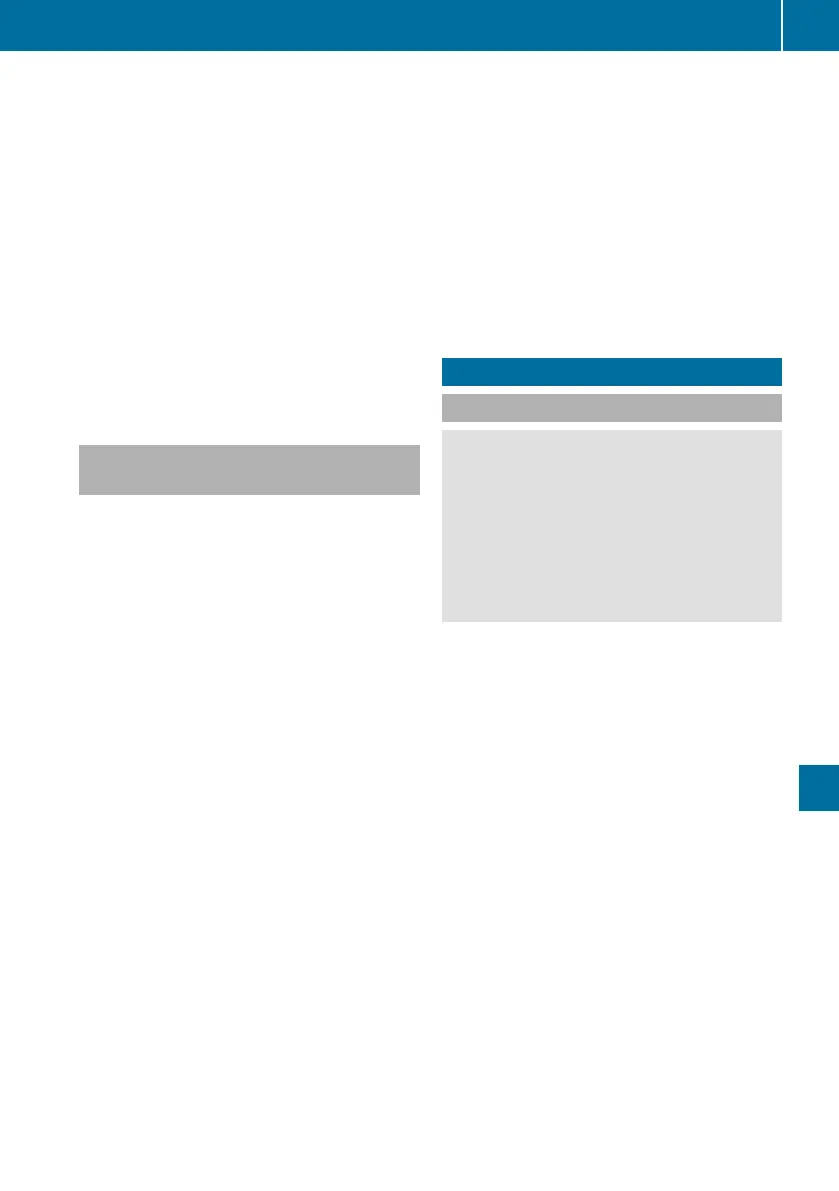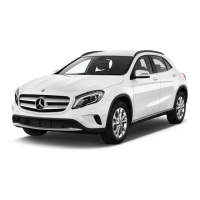Vehicles with 4MATIC may only be either towed
away with both axles on the ground or be loaded
up and transported.
If the vehicle has transmission damage or dam-
age to the front or rear axle, have it transported
on a transporter or trailer.
In the event of damage to the electrical sys-
tem:
If the battery is defective, the automatic trans-
mission will be locked in position j. To shift the
automatic transmission to position i, you
must provide power to the vehicle's on-board
electrical system in the same way as when jump-
starting (Y page 325).
Have the vehicle transported on a transporter or
trailer.
Tow-starting (emergency engine
starting)
!
Do not tow-start vehicles with automatic
transmission. You could otherwise damage
the automatic transmission.
i
You can find information on "Jump-starting"
under (Y page 325).
Before tow-starting, the following conditions
must be fulfilled:
R
the battery is connected
R
the engine has cooled down
R
the exhaust system has cooled down
When tow-starting, it is important that you
observe the safety notes (Y page 327) and the
legal requirements in each respective country.
X
Switch on the hazard warning lamps
(Y page 118).
X
Fit the towing eye (Y page 328).
X
Secure the rigid towing bar or the towing
rope.
X
When the vehicle is stationary, depress the
brake pedal and keep it depressed.
X
Turn the key to position 2 in the ignition lock
(Y page 144).
X
Depress the clutch pedal fully, engage second
gear and continue to keep the clutch pedal
fully depressed.
X
Release the brake pedal.
X
Tow-start the vehicle.
X
Release the clutch pedal slowly; do not
depress the accelerator pedal while doing so.
X
When the engine has been started, immedi-
ately depress the clutch pedal fully and shift
to neutral.
X
Pull over at a suitable place and stop the vehi-
cle safely, paying attention to road and traffic
conditions.
X
Use the electric parking brake to secure the
vehicle and prevent it from rolling away.
X
Remove the rigid towing bar or towing rope.
X
Remove the towing eye (Y page 329).
X
Switch off the hazard warning lamps.
Fuses
Important safety notes
G
WARNING
If you manipulate, bridge or replace a faulty
fuse with a fuse of a higher amperage, the
electric cables could be overloaded. This may
result in a fire. There is a risk of an accident
and injury.
Always replace faulty fuses with specified new
fuses of the correct amperage.
!
Only use fuses that have been approved for
Mercedes-Benz vehicles and which have the
correct fuse rating for the system concerned.
Only use fuses marked with an "S". Compo-
nents or systems could otherwise be dam-
aged.
!
Make sure that no moisture can enter the
fuse box when the cover is open.
!
When closing the cover, make sure that it is
lying correctly on the fuse box. Moisture seep-
ing in or dirt could otherwise impair the oper-
ation of the fuses.
The fuses in your vehicle disconnect faulty cir-
cuits. If a fuse blows, all the components in the
circuit and their functions will fail.
Blown fuses must be replaced with fuses of the
same rating, which you can recognise by the
colour and fuse rating. The fuse ratings are listed
in the fuse allocation chart.
The fuse allocation chart is in the fuse box in the
front-passenger footwell (Y page 332).
If the newly inserted fuse also blows, have the
cause traced and rectified at a qualified special-
Fuses
331
Breakdown assistance
Z

